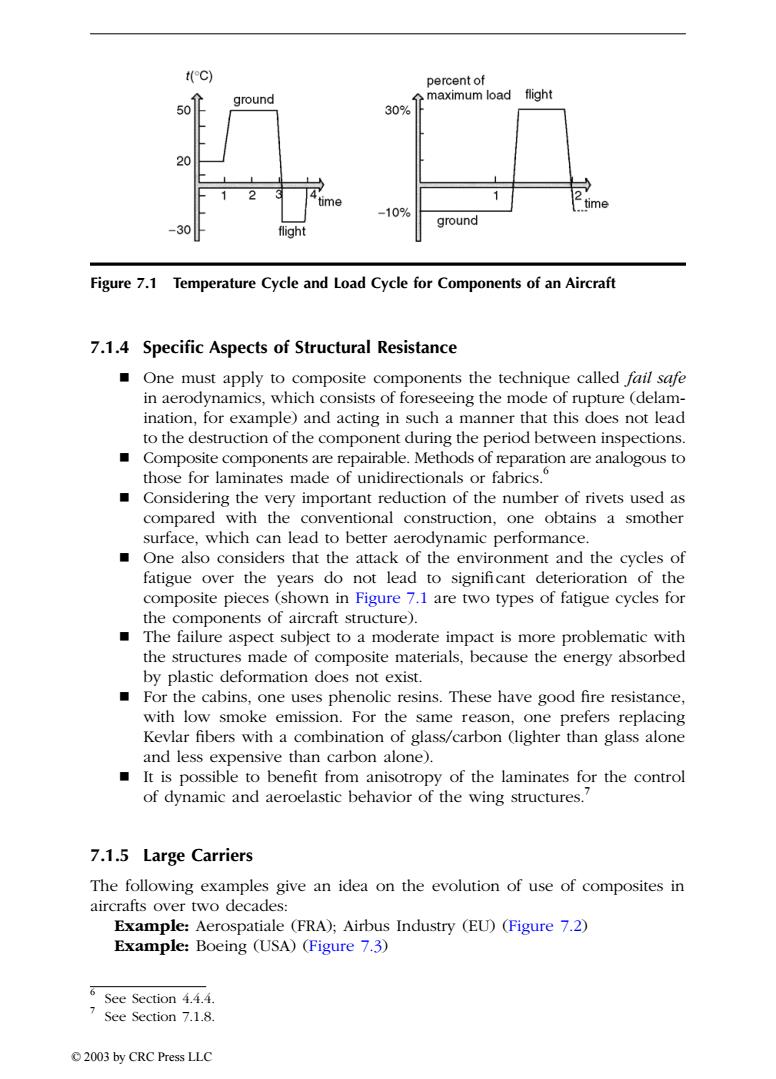正在加载图片...

t(c) percent of ground maximum load flight 30% 20 2 1 time time -10% ground -30 flight Figure 7.1 Temperature Cycle and Load Cycle for Components of an Aircraft 7.1.4 Specific Aspects of Structural Resistance One must apply to composite components the technique called fail safe in aerodynamics,which consists of foreseeing the mode of rupture (delam- ination,for example)and acting in such a manner that this does not lead to the destruction of the component during the period between inspections. Composite components are repairable.Methods of reparation are analogous to those for laminates made of unidirectionals or fabrics. Considering the very important reduction of the number of rivets used as compared with the conventional construction,one obtains a smother surface,which can lead to better aerodynamic performance. One also considers that the attack of the environment and the cycles of fatigue over the years do not lead to significant deterioration of the composite pieces(shown in Figure 7.1 are two types of fatigue cycles for the components of aircraft structure). The failure aspect subject to a moderate impact is more problematic with the structures made of composite materials,because the energy absorbed by plastic deformation does not exist. For the cabins,one uses phenolic resins.These have good fire resistance, with low smoke emission.For the same reason,one prefers replacing Kevlar fibers with a combination of glass/carbon (lighter than glass alone and less expensive than carbon alone). It is possible to benefit from anisotropy of the laminates for the control of dynamic and aeroelastic behavior of the wing structures.' 7.1.5 Large Carriers The following examples give an idea on the evolution of use of composites in aircrafts over two decades: Example:Aerospatiale (FRA);Airbus Industry (EU)(Figure 7.2) Example:Boeing (USA)(Figure 7.3) 6 See Section 4.4.4. See Section 7.1.8. 2003 by CRC Press LLC7.1.4 Specific Aspects of Structural Resistance One must apply to composite components the technique called fail safe in aerodynamics, which consists of foreseeing the mode of rupture (delamination, for example) and acting in such a manner that this does not lead to the destruction of the component during the period between inspections. Composite components are repairable. Methods of reparation are analogous to those for laminates made of unidirectionals or fabrics.6 Considering the very important reduction of the number of rivets used as compared with the conventional construction, one obtains a smother surface, which can lead to better aerodynamic performance. One also considers that the attack of the environment and the cycles of fatigue over the years do not lead to significant deterioration of the composite pieces (shown in Figure 7.1 are two types of fatigue cycles for the components of aircraft structure). The failure aspect subject to a moderate impact is more problematic with the structures made of composite materials, because the energy absorbed by plastic deformation does not exist. For the cabins, one uses phenolic resins. These have good fire resistance, with low smoke emission. For the same reason, one prefers replacing Kevlar fibers with a combination of glass/carbon (lighter than glass alone and less expensive than carbon alone). It is possible to benefit from anisotropy of the laminates for the control of dynamic and aeroelastic behavior of the wing structures.7 7.1.5 Large Carriers The following examples give an idea on the evolution of use of composites in aircrafts over two decades: Example: Aerospatiale (FRA); Airbus Industry (EU) (Figure 7.2) Example: Boeing (USA) (Figure 7.3) Figure 7.1 Temperature Cycle and Load Cycle for Components of an Aircraft 6 See Section 4.4.4. 7 See Section 7.1.8. TX846_Frame_C07 Page 139 Monday, November 18, 2002 12:17 PM © 2003 by CRC Press LLC